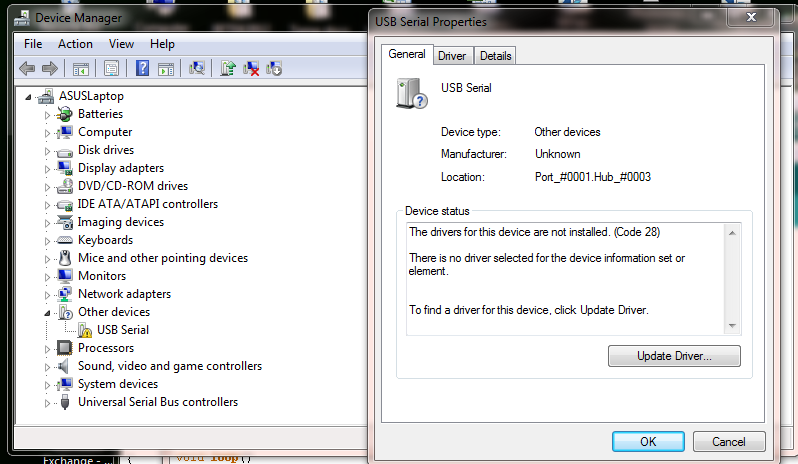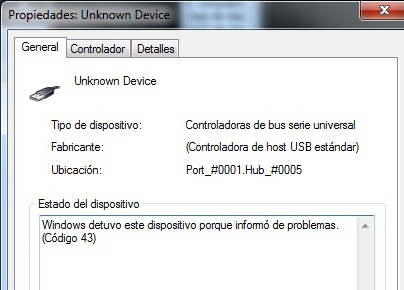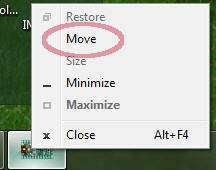How Quickly Can The Teensy 3.6 Register An Interrupt
Troubleshooting Common Problems
If your question isn't answered here, please post on the forum. PJRC does monitor the forum and every endeavor is made to respond client questions.You lot must post code or details needed to reproduce the problem. Please read the posting guidelines. But a few minutes to etch a detailed question usually results in much better aid.
The Teensy Quick Reference: Code Examples, Tips and Tricks list has a list useful resources and solutions for many common projects.
The Most Common Problems
#one: LED Blinks But No USB Communication: Many cell phones are sold with charging-merely cables. They have but two wires for ability, but are missing the ii data wires. Try another USB cablevision, ideally one known to work for USB.#2: No COM Port or Serial Device Seen: Teensy uses HID protocol for uploading, non series. Brand new Teensy boards are shipped with the LED blink example compiled to appear as RawHID. Y'all must program Teensy at least once from Arduino. The COM port (Windows) or Serial Device (Mac, Linux) appears only after Teensy begins running your programme. Regular Arduino boards are always serial. Teensy uses HID and supports many protocols. To employ series, make sure the Tools > USB Type menu is set up to "Series", and understand Teensy only becomes a serial device when it runs your plan built with this setting.
#iii: Dead (usually overheating) Main Chip: More than four volts applied to the 3.3V power pivot instantly kills a Teensy LC or 3.2. Be extremely careful if connecting circuits to Teensy using both VIN(5V) & three.3V pins, or when using any external power supply. Loose wires between Teensy and other electonics accidentally touching are the most common mode Teensy fails. Merely a few extra minutes to embrace exposed leads and mechanically secure loose wires, peculiarly if they tin easily unplug from a solderless breadboard, can save yous from an unpleasant and plush "learning experience".
Unreliable Advice
Some USB hubs have trouble treatment the rapid sequence of connect/disconnect events when programming Teensy. Most hubs work fine, but the few that do not can cause very strange problems. If yous feel trouble, always try connecting Teensy directly with a quality USB cable.Teensy 3.0 Not Recognized by Teensy Loader
Teensy Loader 1.07 is the first version to back up Teensy iii.0. Y'all can check the version using Help > Virtually. Version 1.07 is part of the Teensyduino installer. It automatically runs when yous click Upload or Verify in Arduino.Brand New Teensy Non Recognized
When a brand new Teensy has never been recognized by Teensy Loader, follow these steps.- Beginning, reboot your computer and remove any other circuitry connected to the Teensy.
- The LED should blink when the USB cablevision is plugged in. Every Teensy is pre-programmed with a LED blink program during product testing. No drivers or software on your computer are needed for the LED blink. Just power from the USB cable is necessary. If the LED does non blink, check the voltage on the board using a voltmeter, or try another cablevision or USB port, and avert whatever USB hubs. If the LED never blinks, do not worry about drivers or software. No LED glimmer indicates the board is not receiving ability!
- When the pushbutton is pressed, the LED should stop blinking. No software or drivers on your computer are necessary for the button to cease the LED glimmer. When the LED blinks and the pushbutton causes the blinking to stop, this is a very good indication your Teensy hardware is operation properly.
- When the LED stops blinking, if the Teensy Loader program is running, it should notice the Teensy board. The "Press Button To Activate" bulletin will disappear and the image will show which lath is present. No drivers demand to be installed on Windows or Mac for this to work. On Linux, the udev dominion file must be installed. If the LED blinks, and the pushbutton stops the blinking, but Teensy Loader never detects your board, and you've followed the steps to a higher place, the problem is almost certainly a faulty USB cable. Many USB cables fabricated for charging devices have but power wires just no data lines.
- On Windows, the driver installation is only necessary for using the Arduino Serial Monitor when Teensy implements a Series device (from the Tools > USB Type menu), and to automatically reprogram using "Upload" when Teensy has been programmed as Series. Without the driver, v seconds after y'all click Upload, a bulletin volition appear asking y'all to press the pushbutton on your Teensy. Windows may requite you misleading errors indicating drivers must exist installed, only NO DRIVER IS NECESSARY on Windows to simply get Teensy Loader to recognize your Teensy and programme new code. Follow steps 1-3 above before worrying about drivers!
Teensy Non Recognized by Teensy Loader
A previously working board may seem to be dead, but the trouble may but exist code on your Teensy which confuses your PC's USB port.- Physically disconnect the Teensy.
- Reboot your reckoner (consummate power off is all-time)
- Brand certain the Teensy Loader application is running.
- Concord the reset button down, earlier plugging in the USB cable.
- Plug the USB cablevision in while continuing to hold the button.
- After the cable is fully inserted, release the button.
On Windows systems, "strange" bug are occasionally reported, where Windows volition not detect new devices. It does non seem to be unique to Teensy. Creating a new user account sometimes solves the problem. Plugging the cable into dissimilar USB ports can also aid. Rebooting is always a good idea. The best approach is to try on a Mac or Linux machine, or a dissimilar Windows car.
No Serial Port While Programming
This is normal. Teensy is Non natively a serial device.Arduino boards appear equally a serial device for all programming and communication. Arduino remains connected as a serial device while it reboots. Teensy is a native USB device. Feel troubleshooting Arduino does not utilise to Teensy!
During programming, Teensy appears as a HID device. When Teensy reboots, electrically your computer sees Teensy disconnect, as if the cable were physically unplugged. When Teensy begins running your plan, the USB is asunder.
The fast and deadening LED blink examples do not enable the USB port.
When programs do use USB, type of device Teensy becomes depends on the code you take loaded. Your computer volition see a new USB device connect when your program begin using the USB port. In Arduino, the device blazon is controlled by the Tools > USB Blazon carte du jour. In C linguistic communication, the USB lawmaking you use make up one's mind the type of device. The hid_listen program only responds to specific C programs. While troubleshooting, you must look for the type of device which your plan implements.
TODO: listing of C code and Teensyduino device types, VID/PID numbers for each.
Pushbutton Does Not Reset Application
The pushbutton lets yous to manually put Teensy into programming manner. With Arduino, this happens automatically when you click Upload. But if your code disables the USB port, or disables interrupts, or enters a deep sleep way which stop the CPU, Teensy can not respond to the USB-based reboot request.Every Teensy is made with a physical pushbutton to allow recovery from a not-responding program.
The pushbutton does NOT reset Teensy to restart your application. However, if Teensy is continued to your computer, and Teensy Loader is running and configured for automated fashion (the default when used with Arduino), pressing the button will enter programming mode. Teensy Loader will speedily reprogram and restart your Teensy. This restart of your application is due to Teensy Loader'due south "auto" mode, not only the pushbutton.
LED Blinks Green or Blueish
Y'all have a counterfeit lath. PJRC has never made any Teensy with a green or blue LED. If y'all purchased using Ebay and Paypal, we recommend you immediately brainstorm a dispute on Paypal's website. Exercise non bother contacting the seller. They have already scammed many other people with defective boards, just they simply do not care. A dispute on Paypal is the but way yous volition recover your money. The sooner y'all file the dispute, the amend your odds of receiving a refund. We recommend waiting to leave negative feedback until after Paypal returns your money.Big Programs Mysteriously Crash
On Teensy two.0, the compiler places string constants in RAM. If you have have many, RAM can run out quickly. In Arduino, you can utilise F() to cause strings used with print() to avoid using RAM.void loop () { Keyboard .print(F("This is long string does not use RAM, due to F()"); Series .println(F("Another string"));delay(250); }
In C linguistic communication, ordinarily PSTR() is used, and special functions which access flash memory must exist chosen. Oft they have a "_P" suffix.
Large data tables or arrays can besides crusade trouble. If data is constant, PROGMEM and pgm_read_byte() can be used. Run across the avr-libc manual for details.
Teensy LC, 3.0, 3.ane do not have this trouble. Variables defined with "const" are placed simply in wink retention, but can be accessed commonly. Merely the older viii bit AVR-based boards require these special steps to forbid strings and read-only variables from consuming limited RAM.
Windows: Series Driver Installed But Not Used
On Windows, even if the serial driver installer has run correctly, sometimes Windows will retain onetime data in its registry and fail to load the driver. The Device Manager volition show "USB Serial" with an mistake, instead of "USB Serial (Advice Class, Abstract Control Model)" with a COM port number assigned.
These deportment usually can crusade Windows to re-detect the device and begin using the right driver.
- Run the serial installer program once again, or run the Teensyduino installer and use the update driver pick on the get-go stride.
- Click that "Update Driver" button in the device managing director. If the commuter installer has run, Windows should exist able to find the driver.
- Plug the cable into a different USB port. The Windows Registry handles each physical port with separate registry entries.
- Do and/all of the higher up with or without the device connected. Sometimes Windows will do things differently if the device is nowadays or absent.
If there is no "USB Series" at all, please rememober Teensy only becomes a Serial device when programmed to practise so. See "No Serial Port While Programming" above.
Windows 7: Unknown Device (Lawmaking 43)
Windows "Code 43" is a mystery. Other devices, even Apple tree iPod, have experienced this problem. The solution seem to be be completely powering downwards, and if a latop, remove the battery for a few minutes. This aforementioned solution has been reported multiple times with success.This code 43 error is a mystery. Information technology might be related to laptops entering suspend mode? If you have whatsoever insight, please contact us!
Pieter Rautenbach found a case where programming the wrong HEX file (compiled for a unlike chip) causes error 43.

Windows: Teensy Loader Window Does Non Announced
On Windows, if multiple monitors are used and then only a single monitor is later used (eg, a laptop used at a docking station), the Teensy Loader may attempt to announced on the missing monitor. The Teensy Loader appears in the Windows Task Bar, just not on the screen.- Windows 7: Hold the shift key and right click on the Teensy Loader in the Task Bar.
Windows Vista & XP: Right click on the Teensy Loader in the Chore Bar. - Select "Move".
- Use your keyboard arrow keys to motility the window until it appears.

Boosted info from Gilbert Hersschens:
"Since you lot tin can't see the missing window, y'all won't know for sure if information technology's visible or subconscious. Simply you lot can see this in the context menu. When the window is shown on the missing display, the menu detail "Move" will be agile and the item "Restore" will be greyed out. When it's hidden, it will be just the opposite. You tin can only move a window in its visible state. To hide or unhide a window, yous can click on the icon in the taskbar to toggle its state or utilise the respective carte du jour items in the context menu.
Linux: Gentoo & Arch AVR Toolchain
The AVR toolchains provided by Gentoo and Arch are broken. They compile .hex files which simply do non piece of work! Starting with version 1.0.1, Arduino downloading from www.arduino.cc has a known-proficient toolchain.If running avr-gcc with a makefile, download Arduino ane.0.one and set your $PATH to access the toolchain in arduino-one.0.1/hardware/tools/avr/bin directory.
Linux: Long Filibuster Before USB Serial Detected
On some Linux systems, USB Serial is detected very slowly. The kernel detects the device quickly (usually seen with "tail -f /var/log/messages"), merely the device files do not announced for a very long time.Edit "/lib/udev/rules.d/77-nm-probe-modem-capabilities.rules", adding this line:
SUBSYSTEMS=="usb", ATTRS{idVendor}=="16c0", ATTRS{idProduct}=="04[7-9]?", GOTO="nm_modem_probe_end" Linux: Many Indistinguishable Device Names with Ubuntu 9.10
On Ubuntu ix.x (and possibly other systems), when using a serial device type, the kernel assigns a new number each fourth dimension, /dev/ttyACM0, /dev/ttyACM1, /dev/ttyACM2, etc.This is acquired past the Gnome Modem Manager, which holds the port in (as far as the kerel is concerned) utilize even after you take reset the Teensy and the port no longer exists. The simplest solution is to uninstall Modem Director, and restart the network managing director or simply reboot.
apt-get remove --purge modemmanager
Yous could besides endeavor deleting /usr/lib/ModemManager/libmm-plugin-generic.and so and of course reboot. This might leave Modem Manager able to work with most modems, but not interfere with Teensy.
Modem Manager'south troublesome probing and inability to configure exclusions for specific device is a known bug. Hopefully it will be stock-still in future releases.
Windows: Teensyuino Installer Unable To Write
Please temporarily disable any anti-virus software. Many "heuristic" anti-virus programs do not similar i programme writting to another. The Teensyduino installer needs to modify many files inside the Arduino software. "Windows Essential Security" has been reported to cause problem.How Quickly Can The Teensy 3.6 Register An Interrupt,
Source: https://www.pjrc.com/teensy/troubleshoot.html
Posted by: salinasdelitth.blogspot.com


0 Response to "How Quickly Can The Teensy 3.6 Register An Interrupt"
Post a Comment